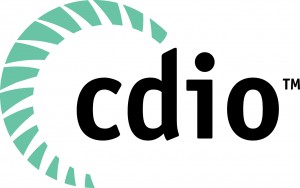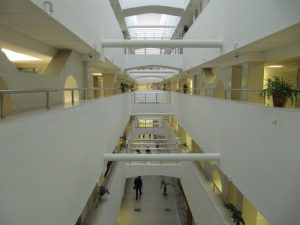 As the Co-director of the CDIO Initiative I was invited for a Russian national conference 25-26 October at a place that was not directly on my mind: Surgut, city in northwest Siberia on the Ob River, about 400,000 inhabitants and home to two of world’s most powerful gas-fired power plants that produce over 7,200 megawatt (which is five times the biggest Eemshaven power plant in the Netherlands) and supply the region with relatively cheap electricity. Approaching the city from air leaves no doubt: Surgut’s economy is tied to oil and gas production; it’s “the Oil Capital of Russia”.
As the Co-director of the CDIO Initiative I was invited for a Russian national conference 25-26 October at a place that was not directly on my mind: Surgut, city in northwest Siberia on the Ob River, about 400,000 inhabitants and home to two of world’s most powerful gas-fired power plants that produce over 7,200 megawatt (which is five times the biggest Eemshaven power plant in the Netherlands) and supply the region with relatively cheap electricity. Approaching the city from air leaves no doubt: Surgut’s economy is tied to oil and gas production; it’s “the Oil Capital of Russia”.
Surgut State University, a 24-year young university with 7500 students and 700 academic staff, invited me to join the conference “CDIO Global Initiative in the Russian Educational System”, to learn about the CDIO-related educational reforms in Russia, welcome the participants on behalf of the CDIO community, share my vision on taking engineering education to 2030, and discuss about my experiences in transforming curricula with the CDIO methodology in mind.
The university is one of 16 Russian universities that are involved in reforming their engineering education to active forms of learning and teaching in accordance with international standards. These universities have decided to implement project education and modernise their bachelor programmes in line with the CDIO methodology. They have to make a big mind shift and major change in hierarchical culture. Do they have the will and possibility to catch up? I was surprised.

The modern building of Surgut State University. It includes a library, theatre, labs and educational spaces. On the right the university’s Temple of the Holy Martyr Tatiana (private photo).
“CDIO in the Russian Education System”
The goal of the conference was to pave the way for a platform where Russian universities share their experiences and discuss common difficulties they face in reforming their programmes to active forms of learning and teaching.
Need for continuous change
The discussions between the approximately 40 participants from six Russian universities taught me that the problem of the widening gap between university education learning outcomes and the professional needs is characteristic for the whole world: wherever we are, the academic community lags behind the rapid developments in technology and society.
I received this confirmative feedback on my keynote speech about the exponential change in technology and the need to adapt academic staff, students, organisation, curricula and learning outcomes accordingly. In this speech I stressed that curricular reform is not a one-off thing. Continuous upgrading remains necessary, also after havig completed a radical change to adapt to the CDIO framework, to stay aligned with changing needs and changing attitudes of new breeds of students.


Taking part in the discussion via the interpreter (left) and (right) serious listeners to my keynote “Taking Engineering Education to 2030” (Photos resource: Surgut State University)
“Student life and our educational programmes have to be based upon engineering fundamentals, but in balance with active learning such as research and design team-based projects, that are connected to authentic problems and opportunities in industry and institutes” said the president of the Russian Association for Engineering Education, Head of the Department of Organization and Technology of Higher Professional Education of the Tomsk Polytechnic University (TPU) Yuri Poholkov.
Out of the Russian comfort zone
During the engaging and interactive expert seminar on the first conference day the participants established a set of criteria that can be used to benchmark the implementation level of project-based education in their university. After José Carlos Quadrado of the Polytechnic of Porto (ISEP) and I had shared the positive as well as critical experiences at our western universities, the participants made a discovery for their own institute what hindered the transformation process and how these obstacles could be overcome. It must have been challenging for some participants to discuss not only the successful, but also the painful and critical issues in all openness, and come up with bottum-up ideas rather than follow directives from hierarchical leaders.
“We still deliver far too much a “theological” type of engineering education: Have the faith that you are going to use at least once in your professional life what we teach you” (quote José Carlos Quadrado in Surgut)
In his speech about the importance of Interdisciplinary Education, José Carlos Quadrado initiated a thrilling “social crowdsourcing of idea generation and discussion”. One-liners about hindrances of interdisciplinary education, written by each participant on a single card, were exchanged multiple times, discussed, compared, graded in duos and written on the card (the sum of the two marks being 10) in less than a minute. Repeating this cycle five times created a very lively atmosphere where everybody met new people for a short moment and discussed arguments for one-liners they had not written by themselves. The session was concluded by adding up the grades per one-liner. In no time the crowd thus had created a ranking of hindrances for the implementation of interdisciplinary education. Most importantly, the social crowdsourcing had broken the ice between the participants.
Engineering education and more
“I consider the outcome as an important result of comprehension of the CDIO standards,” said Sergei Kosenok, rector of the University of Surin State University. “Although CDIO was originally proposed for the development of engineering education, it now becomes clear that the ideology in question can also be applied in the training of specialists of any other discipline. The gap between learning outcomes of academic education and the needs of professional practice exists in many branches of the real economy, not only in engineering. Authentic design and research projects for students of whatever discipline should therefore not only address their own discipline but become an integration of technical, social and economic disciplines”.


The modern interior of Surgut State University’s main building (left) and the library (right) (private photos)
CDIO as the main toolbox for educational transformation
Many Russian universities adopt the CDIO framework as the international standard and choose the methodology as a toolbox for the transformation of their curricula. The World Bank in Moscow, also present at the conference, stimulates universities to innovate and adopt this uniform approach, for reasons that I wrote in my blogpost discussing the ready-to-use framework. I also learnt that Russian universities have a tradition of on-campus and distance education and see an increasing demand for online education. About 20% of all students in higher education take some online education.
Although the Russian higher education system changes slowly, every year more universities are included in international rankings. They not only enter the QS World University Rankings: BRICS, but make relatively rapid progress towards the top. Among Russian universities TPU (Tomsk) occupies the 11th place in this QS BRICS ranking. The numerous papers about educational change, presented at CDIO conferences in the past, and the interactive role and professional attitude in the expert seminar at the conference by professor Yuri Poholkov and Kseniaya Zaitseva, manager of international projects at TPU, demonstrated the open and innovative culture at this university. Also has TPU, together with Skoltech, been the frontrunner in the development of online material about the CDIO standards on the edX platform.
Skoltech as a special case.
Skoltech, founded in 2011 with its mission to accellerate innovation, has developed Master programmes to bridge from science to innovation and educate young people to become leaders and agents of change. Their programmes are fully based on the CDIO principles and link research to innovation. Twentyfive per cent of their programmes are dedicated to innovation and entreneurship. Clement Fortin explained that a recent assessment showed that the impact their education has on society is 30 times the combined impact of the research achievements and innovation.
The curricular structures in their Master’s are based on six-week blocks of topical learning, followed by one-week summative assessment, followed by one-week intensive project to use new knowledge, build a structure of knowledge and develop self-efficacy. These projects carry learning outcomes on personal and interpersonall skills and their assessment.
Trends in Russian higher education
The second day of the conference was fully devoted to presentations and discussions of practices of Russian universities. Andrey Zolotarev, expert of innovations of the World Bank in Moscow opened the meeting. He presented an overview of international trends in higher education, which Russian universities, regardless of location and status, should take into account to be competitive. He referred to the increase in the openness and globalization of education, the decline in financial state support and the transition to competitive finance, the changing values and demands of students, the active introduction of new technologies, the development of new pedagogy, and the changing competences that a student must acquire while studying at a university. His presentation seamlessly complemented mine the day before.
Innovative advancements and setbacks

The formal setting at the beginning of the conference (Source: Surgut State University)
Speeches from representatives of the Siberian Federal University (Krasnoyarsk, 3000 km east of Surgut) addressed the problems that arise when curricula are transformed from a traditional curriculum to a CDIO compatible framework. Frequent problems are the lack of readiness of the organisation and facilities, resistance of teachers in particular, to change from transferring knowledge to also developing and tutoring design projects. All western universities encountered exactly the same issues 10-15 years ago. What’s new?
Alexander Arnautov, senior lecturer at Siberian Federal University, presented how they transformed the first-year Bachelor course “Introduction to Engineering” from lecturing abstract knowledge to a programme with a complementary network game where 120 students from three different disciplines play engineering and entrepreneurial roles. The students choose their team which represents a fictitious engineering company. Using basic knowledge they design and analyse a product or system for the real world and take customer needs into account. After a while the teams c.q. companies “trade” and compete with each other in an online game. In this very early stage of their study the students have to acquire additional knowledge, find solutions independently, integrate theories and learn to understand the different languages of the three disciplines: Their lifelong learning has started!
Freezing temperatures and a very warm welcome
Honestly speaking I had some doubts when I received the invitation to attend the conference in Surgut, a remote location in Siberia. I could not have been more wrong.
I was taken aback by the perfect organisation and logistics, the interpreters, the city tour, the food, the punctuality of the conference schedule, the excellent and brand new university buildings and facilities. Together with students the conference participants enjoyed the very impressive and emotional theatre play about War and Love by the Student’s Theatre of Surgut State University “Grotesque”. It was the kindness and devotion of the staff and students of Surgut State University and the conference participants that made this a memorable conference to me.




1 Response to Russia’s catching up on active forms of engineering education